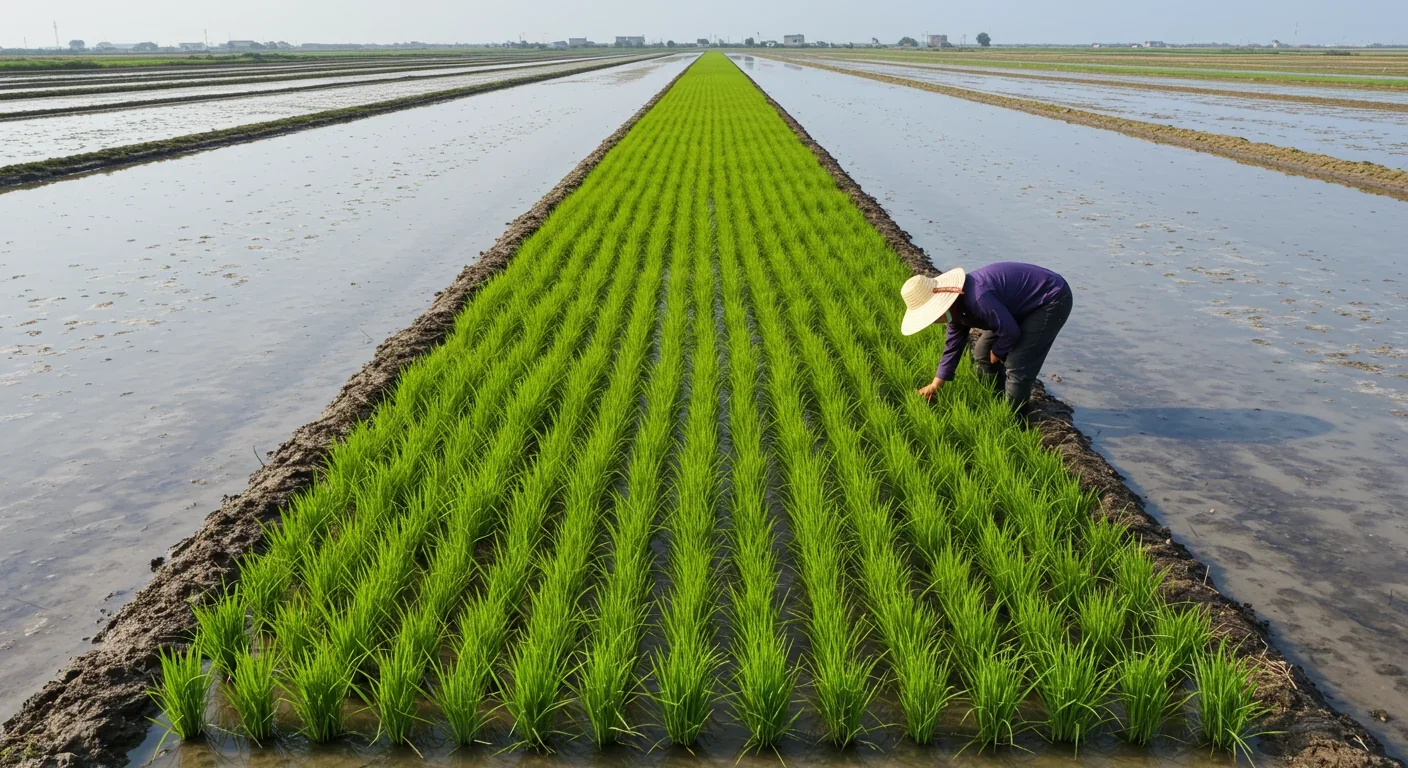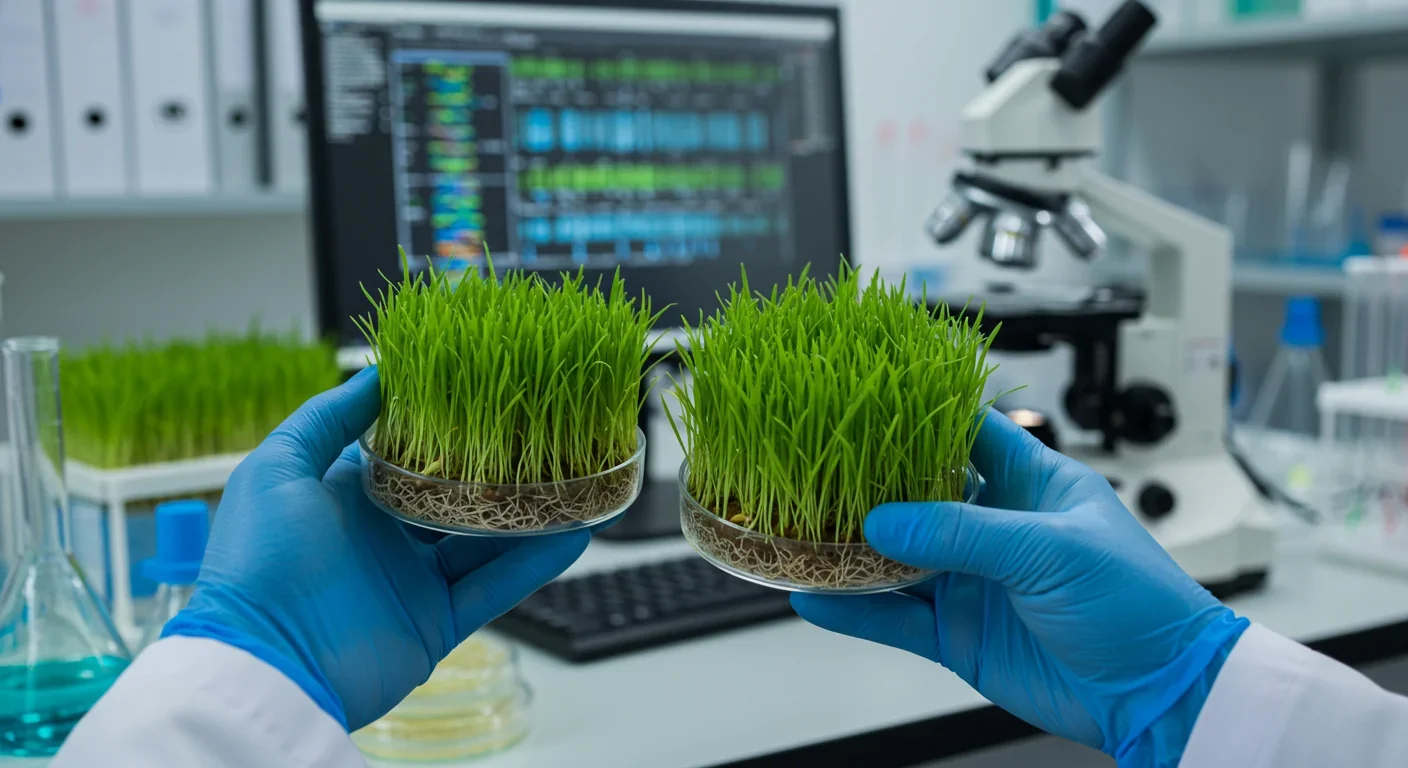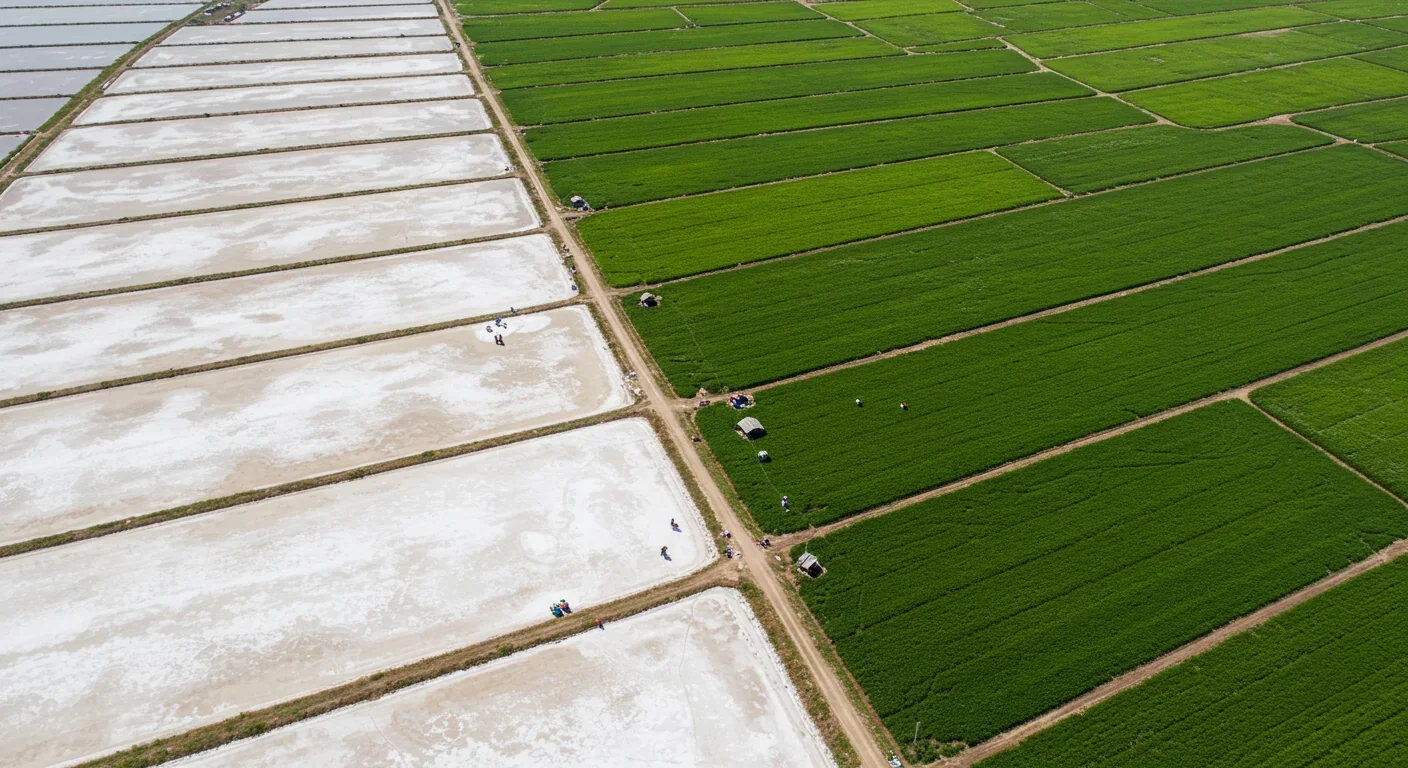Underground Air Storage: Renewable Energy's Hidden Battery

TL;DR: Scientists are engineering crops that thrive in salty soil using genes from natural halophytes, potentially unlocking 1.4 billion hectares of currently unusable land to feed a growing population facing climate-driven food insecurity.

By 2050, we'll need to feed nearly 10 billion people. But here's the catch: we're running out of farmable land while climate change is making existing farmland saltier. More than 25% of Earth's total land and 33% of irrigated cropland already suffer from salinity and sodicity, threatening soil fertility and food security. The ocean keeps rising, coastal regions keep flooding, and farmers keep watching their fields turn white with salt deposits. Traditional wisdom says you can't grow food in salty soil. Scientists are proving that wisdom wrong.
In coastal China, rice paddies that would have been abandoned a decade ago now produce 8.8 tons per hectare using specially engineered varieties. In the Netherlands, farmers are irrigating potatoes, carrots, and broccoli with salt water and watching them thrive. A research team at Yangzhou University needed 34,000 genetic crosses to create a single successful rice embryo, but that one embryo changed everything. The hybrid they developed uses specialized leaf glands that actually excrete salt into the atmosphere, a biological innovation borrowed from wild rice species that evolved in coastal marshes.
This isn't genetic modification in the controversial GMO sense. It's precision breeding, using CRISPR and traditional selection to find the genes that already exist in nature and move them into crops we rely on. The results are staggering. Salt-tolerant crops can boost yields by 30-40% in environments where conventional varieties would fail completely.
As of 2021, China has planted these engineered rice varieties across 400,000 hectares of previously marginal land. That's nearly a million acres producing food where saltwater intrusion would have made farming impossible. The FAO recently launched its first major global assessment of salt-affected soils in 50 years because the problem has grown urgent enough to demand coordinated international response.
Most crops die in salty soil because sodium ions disrupt the delicate chemical balance inside plant cells. Imagine trying to maintain your body's electrolyte balance while drinking seawater. That's essentially what conventional wheat and rice face when irrigated with brackish water. But some plants figured out how to thrive in these conditions millions of years ago.
Mangroves are the original salt-tolerance champions. They evolved multiple strategies: some species filter out 90% of salt at their roots, others concentrate salt in older leaves that they then shed, and a few actually excrete salt crystals through specialized glands on their leaves. Scientists studying these natural halophytes discovered the genetic toolkit for salt tolerance has been hiding in plain sight all along.
The key genes control three main processes. First, salt exclusion mechanisms keep sodium from entering root cells in the first place. Second, compartmentalization systems sequester any sodium that does get in, storing it in cellular vacuoles where it can't damage essential proteins. Third, compatible solute production lets cells manufacture organic compounds that balance osmotic pressure without toxic effects.
Researchers at the International Rice Research Institute crossed commercial rice variety IR56 with wild rice species Oryza coarctata, which grows in coastal estuaries. The resulting hybrid inherited those specialized leaf glands, creating a rice plant that essentially sweats out excess salt. This biological engineering required patience – 34,000 crosses for one successful embryo – but it proved the concept works.
Modern genome editing techniques are accelerating the process dramatically. Instead of random crosses and decades of selective breeding, CRISPR allows scientists to precisely activate or enhance existing salt-tolerance genes. They're not inserting foreign DNA; they're turning up the volume on capabilities plants already possess but rarely express.
The University of California Davis tested barley irrigated with pure seawater at their Bodega Bay laboratory on the Pacific Ocean. They achieved roughly half the normal yield per acre. That might sound disappointing until you realize conventional barley would produce zero yield in those conditions. Halving your output while using land that was previously worthless represents a massive gain in total food production capacity.
The Netherlands' Salt Farm Texel runs 56 experimental plots testing crop tolerance under controlled conditions. They use intensive drip irrigation delivering 10+ millimeters per day at salinity levels ranging from 2 to 35 dS/m, essentially testing everything from slightly brackish to full seawater. The Dutch government reported a breakthrough in food security when specific varieties of potatoes, carrots, red onions, white cabbage, and broccoli showed they could thrive under salt irrigation.
In the United Arab Emirates, a desert farm is growing thousands of tons of wheat using AI-optimized irrigation and desalinated water. The project demonstrates that even in extreme environments, combining salt-tolerant genetics with precision agriculture creates viable food production. The AI monitors soil moisture, salt concentrations, and plant stress markers in real-time, adjusting irrigation to maintain optimal growing conditions.
Israel has become a global leader in agricultural innovation partly because water scarcity forced them to develop drought and salinity-tolerant crops decades ago. Their techniques for managing saline irrigation water now inform projects from India to sub-Saharan Africa. Drip irrigation technology, pioneered in Israeli deserts, reduces water use by up to 70% while preventing salt accumulation around roots.
Bangladesh faces an existential threat from rising sea levels pushing saltwater into the Ganges Delta, one of the world's most productive rice-growing regions. Salt-tolerant rice varieties are no longer experimental there; they're becoming essential for survival. Farmers who plant these varieties maintain yields even as their neighbors' conventional crops fail.

Traditional plant breeding involves crossing two parent plants and hoping beneficial traits appear in offspring. It's slow, imprecise, and often takes 10-15 years to develop a new variety. Modern genome editing changes this completely.
CRISPR-Cas9 acts like molecular scissors, allowing scientists to make precise edits to plant DNA. For salt tolerance, researchers can activate genes that control sodium transporters, enhance those that produce protective proteins, or modify metabolic pathways that synthesize osmoprotectants. Recent studies show edited crops demonstrate enhanced tolerance to multiple stresses simultaneously, not just salinity.
The process starts with identifying candidate genes in naturally salt-tolerant species. Halophytes like Salicornia can grow in pure seawater, making them valuable genetic libraries. Scientists sequence their genomes, identify the genes responsible for salt tolerance, and then look for equivalent sequences in crop species. Often these genes already exist in crops but remain inactive. A simple edit to the gene's regulatory region can switch it on.
Multiple research teams are taking complementary approaches. Some focus on improving salt exclusion at roots. Others work on enhancing vacuolar compartmentalization of sodium within cells. A third group targets the production of compatible solutes like proline and glycine betaine, organic compounds that help cells maintain proper osmotic balance without toxic effects.
The combination of approaches creates synergistic benefits. A rice variety might exclude 80% of salt at the roots, compartmentalize most of what gets through, and produce protective compounds to handle the rest. Stack these defenses and you get plants that can handle salinity levels that would kill their wild-type cousins within days.
Expanding agriculture into saline lands isn't ecologically neutral. Coastal saline soils often support unique ecosystems with species adapted to those specific conditions. Converting these areas to cropland means habitat loss. Mangrove ecosystems provide crucial storm protection, carbon sequestration, and nursery habitat for fisheries. Trading mangroves for rice paddies might solve food security in the short term while creating long-term environmental costs.
But the alternative might be worse. If we don't expand agriculture into marginal lands, growing food demand will drive further deforestation of rainforests and conversion of grasslands. Using land already degraded by salt may represent the lesser evil. The UN report warns that 1.4 billion hectares of land globally face salt stress, an area roughly the size of Antarctica.
Water management becomes critical. Optimized water-fertilizer coupling can reduce excessive fertilizer application and improve soil microbial diversity, potentially mitigating further salinity buildup. Precision irrigation prevents the cycle where poor water management increases soil salinity, which then requires more water, which accelerates salinization.
Some researchers advocate for farming actual halophytes rather than engineering conventional crops. Species like Salicornia and quinoa naturally tolerate high salinity and offer nutritional benefits. Halophyte trials using pure seawater achieved relative yields of 90% for forage crops like Atriplex lentiformis. These plants could provide livestock feed while leaving arable land for human food crops.
The soil microbiome responds to salt-tolerant crops in complex ways we're only beginning to understand. Some salt-tolerant varieties alter root exudates, changing which microbial species colonize the rhizosphere. These shifts can either enhance or reduce soil health depending on the specific crop-microbe combinations. More research is needed to optimize these interactions.
Developing a new crop variety costs millions of dollars and takes years even with modern tools. Who pays for that, and who profits? For subsistence farmers in Bangladesh or coastal West Africa, the economics need to work at the village level. Seeds must be affordable, ideally saved and replanted without patent restrictions.
Private companies investing in agricultural biotech want returns on their research spending. This creates tension. Gene-edited crops occupy a legal gray zone in many countries. Some nations regulate them like GMOs, requiring expensive approval processes. Others treat precise edits that could occur naturally as non-GMO, enabling faster deployment.
The European Union has struggled with this question for years. Strict GMO regulations essentially ban most gene-edited crops despite their potential benefits. Meanwhile, countries facing immediate food security threats take more pragmatic approaches. Bangladesh approved gene-edited salt-tolerant rice because rising sea levels gave them no choice.
Yield improvements of 30-40% in saline conditions translate to significant economic gains. A farmer who abandons two hectares of salt-damaged land but maintains full production on three hectares using salt-tolerant varieties comes out ahead. The comparative impact data shows enhanced rice strains and halophytes can increase productivity substantially when conventional crops would fail.
Infrastructure matters too. Salt-tolerant crops often require modified irrigation systems and soil management practices. Smallholder farmers need access to technical support and financing. Government extension services and agricultural development programs play crucial roles in technology transfer. The seeds themselves might be cheap, but learning to use them effectively requires investment in education and infrastructure.

Climate change is making the salt problem worse every year. Rising seas push saltwater into coastal aquifers and river deltas. Increased evaporation in hot climates concentrates salt in irrigated soils. Extreme weather events bring storm surges that contaminate previously fresh agricultural land. The Guardian reports that global food production faces increased risk from excess soil salt, according to UN warnings.
Meanwhile, the human population keeps growing and getting wealthier. More people eating more resource-intensive diets means agriculture must expand or intensify. We've already converted most of the planet's easily farmable land. What remains is either ecologically precious rainforest or marginal land with problems like salinity, drought, or poor soil quality.
Salt-tolerant crops offer a way to bring marginal land into production without destroying remaining forests. The 1.4 billion hectares affected by salt stress represent enormous potential if we can make them productive. Even modest yields on previously worthless land add up to significant food production when multiplied across millions of hectares.
Different regions face different urgency levels. Island nations and coastal countries with dense populations can't simply relocate agriculture inland. For them, adapting to saline conditions is existential. The Maldives, Bangladesh, and Pacific island nations are already experiencing agricultural losses from saltwater intrusion.
Inland regions face salinization from irrigation itself. When you water crops in hot, dry climates, much of that water evaporates, leaving dissolved salts behind. Over decades, even freshwater irrigation can turn soil salty. Parts of California's Central Valley, Australia's Murray-Darling Basin, and irrigation districts across Central Asia show this pattern. They need salt-tolerant crops not because of climate change directly, but because intensive agriculture created its own salinity problem.
International cooperation could accelerate progress. The FAO's global assessment of salt-affected soils represents a first step toward coordinated action. Sharing research findings, germplasm, and best practices helps everyone. A salt-tolerant wheat variety developed for coastal Morocco might work equally well in Pakistan's Indus Delta.
The technology exists. Scientists have proven that crops can be engineered or bred to tolerate high salinity. Pilot projects demonstrate commercial viability. But scaling from thousands of hectares to hundreds of millions requires political will, investment, and regulatory clarity.
Agricultural research funding competes with countless priorities. Convincing governments to invest heavily in salt-tolerant crop development means demonstrating clear returns. The economic case grows stronger every year as climate change accelerates and food prices rise. A recent study in PLOS ONE examined salt tolerance mechanisms, adding to the growing body of evidence supporting large-scale deployment.
Regulatory frameworks need updating. Gene-editing rules written decades ago don't account for modern precision techniques. A plant with enhanced expression of its own existing genes shouldn't require the same scrutiny as one with foreign DNA inserted. But public perception of "genetic modification" remains fraught with suspicion in many places.
Farmer adoption depends on practical benefits outweighing costs and risks. New seed varieties, modified irrigation practices, and changed soil management all require upfront investment. Demonstration projects and extension services help, but ultimately farmers need to see neighbors succeeding before they commit.
The next decade will likely see exponential growth in salt-tolerant crop deployment. China's 400,000 hectares of seawater rice could expand to millions as the technology matures. Other Asian countries facing similar challenges will follow. African nations dealing with degraded soils and erratic rainfall will experiment with salt-tolerant varieties of local staples like sorghum and millet.
We're witnessing agriculture's adaptation to a saltier world. The question isn't whether this will happen, but how quickly we can scale solutions to match the scope of the challenge. Every year of delay means more farmland lost to salinization and more food insecurity. The tools exist. Using them effectively will determine whether we can actually feed 10 billion people by 2050 or face shortages that destabilize entire regions.
The rice growing in China's coastal fields and the potatoes irrigated with salt water in Dutch greenhouses aren't just experimental curiosities. They're previews of agriculture's necessary future, where crops engineered for resilience help humanity adapt to the planet we've created.

MOND proposes gravity changes at low accelerations, explaining galaxy rotation without dark matter. While it predicts thousands of galaxies correctly, it struggles with clusters and cosmology, keeping the dark matter debate alive.

Ultrafine pollution particles smaller than 100 nanometers can bypass the blood-brain barrier through the olfactory nerve and bloodstream, depositing in brain tissue where they trigger neuroinflammation linked to dementia and neurological disorders, yet remain completely unregulated by current air quality standards.

CAES stores excess renewable energy by compressing air in underground caverns, then releases it through turbines during peak demand. New advanced adiabatic systems achieve 70%+ efficiency, making this decades-old technology suddenly competitive for long-duration grid storage.

Our brains are hardwired to see patterns in randomness, causing the gambler's fallacy—the mistaken belief that past random events influence future probabilities. This cognitive bias costs people millions in casinos, investments, and daily decisions.

Forests operate as synchronized living systems with molecular clocks that coordinate metabolism from individual cells to entire ecosystems, creating rhythmic patterns that affect global carbon cycles and climate feedback loops.

Generation Z is the first cohort to come of age amid a polycrisis - interconnected global failures spanning climate, economy, democracy, and health. This cascading reality is fundamentally reshaping how young people think, plan their lives, and organize for change.

Zero-trust security eliminates implicit network trust by requiring continuous verification of every access request. Organizations are rapidly adopting this architecture to address cloud computing, remote work, and sophisticated threats that rendered perimeter defenses obsolete.